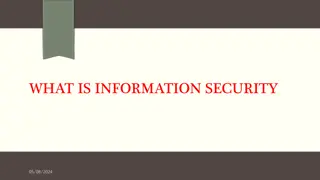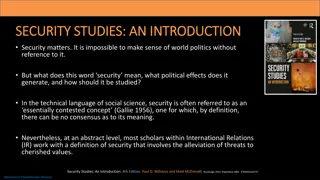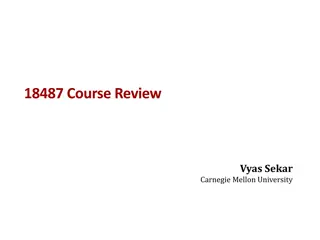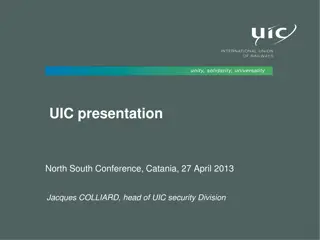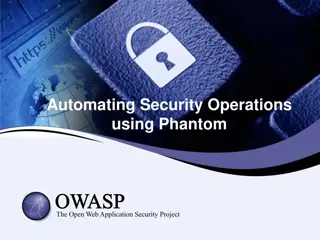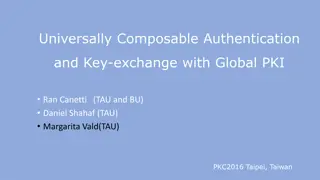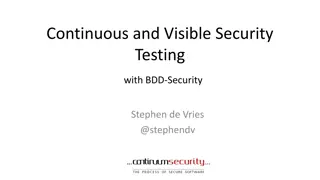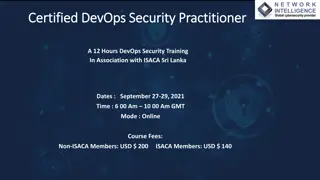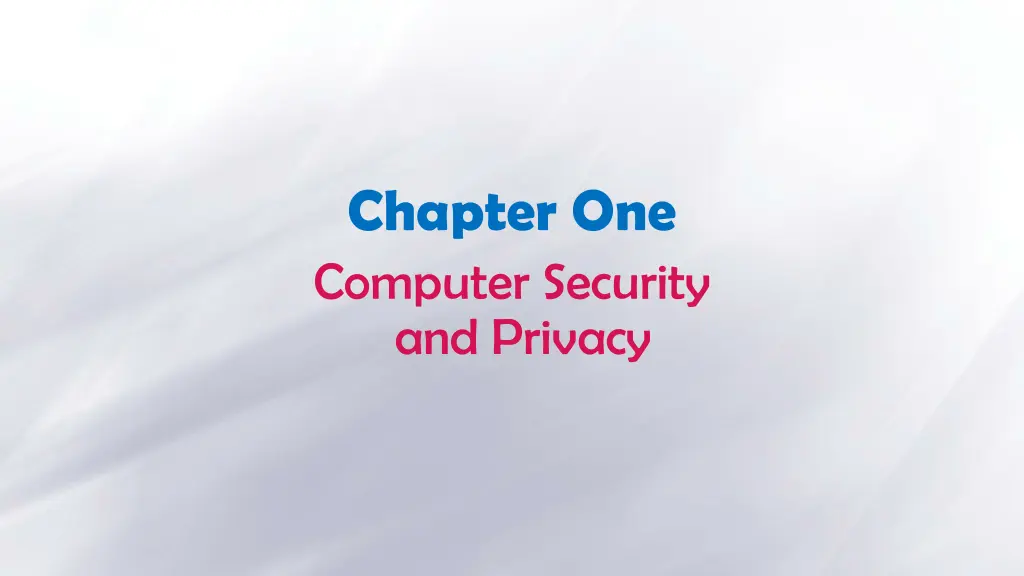
Computer Security and Privacy: Evolution and Importance
Explore the evolution of computer security and privacy from the 1960s to the modern era, highlighting the shift towards interactive systems, growing concerns over data protection, and the emergence of LANs and the Internet. Learn about the key concepts, goals, and historical developments in safeguarding computer assets and individual privacy.
Download Presentation

Please find below an Image/Link to download the presentation.
The content on the website is provided AS IS for your information and personal use only. It may not be sold, licensed, or shared on other websites without obtaining consent from the author. If you encounter any issues during the download, it is possible that the publisher has removed the file from their server.
You are allowed to download the files provided on this website for personal or commercial use, subject to the condition that they are used lawfully. All files are the property of their respective owners.
The content on the website is provided AS IS for your information and personal use only. It may not be sold, licensed, or shared on other websites without obtaining consent from the author.
E N D
Presentation Transcript
Chapter One Computer Security and Privacy
Computer Security and Privacy The most secure computers are those not connected to the Internet and shielded from any interference air gap jumping
Computer Security and Privacy Computer security is about provisions and policies adopted to protect information and property from theft, corruption, or natural disaster while information and property to remain accessible and productive to its intended users. allowing the
Computer Security and Privacy Network security on the other hand deals with provisions and policies adopted to prevent and monitor unauthorized access, misuse, modification, or denial of the computer network and network- accessible resources. Not Sufficient!! Internet
Computer Security and Privacy Security Goals: to achieve CIA Confidentiality Integrity Availaibility
Computer Security and Privacy/ Overview Definitions Security: The prevention and protection of computer assets from unauthorized access, use, alteration, degradation, destruction, and other threats. Privacy: The right of the individual to be protected against intrusion into his personal life or affairs, or those of his family, by direct physical means or by publication of information. Security/Privacy Threat: Any person, act, or object that poses a danger to computer security/privacy.
Computer Security and Privacy/ History Until 1960s computer security was limited to physical protection of computers In the 60s and 70s Evolutions Computers became interactive Multiuser/Multiprogramming was invented More and more data started to be stored in computer databases Organizations and individuals started to worry about What the other persons using computers are doing to their data What is happening to their private data stored in large databases
Computer Security and Privacy/ History In the 80s and 90s Evolutions Personal computers were popularized LANs and Internet invaded the world Applications such as E-commerce, E-government and E-health started to develop Viruses become majors threats Organizations and individuals started to worry about Who has access to their computers and data Whether they can trust a mail, a website, etc. Whether their privacy is protected in the connected world
Computer Security and Privacy/ History Famous security problems Morris worm Internet Worm November 2, 1988 a worm attacked more than 60,000 computers around the USA The worm attacks computers, and when it has installed itself, it multiplies itself, freezing the computer It exploited UNIX security holes in Sendmail and Finger A nationwide effort enabled to solve the problem within 12 hours Robert Morris became the first person to be indicted under the Computer Fraud and Abuse Act. He was sentenced to three years of probation, 400 hours of community service and a fine of $10,050 Finally he is associate professor at the Massachusetts Institute of Technology (MIT)
Computer Security and Privacy/ History Famous security problems NASA shutdown In 1990, an Australian computer science student was charged for shutting down NASA s computer system for 24 hours Airline computers In 1998, a major travel agency discovered that someone penetrated its ticketing system and has printed airline tickets illegally Bank theft In 1984, a bank manager was able to steal $25 million through un-audited computer transactions
Computer Security and Privacy/ History Famous security problems In Ethiopia Employees of a company managed to change their salaries by fraudulently modifying the company s database In 1990s Internet password theft Hundreds of dial-up passwords were stolen and sold to other users Many of the owners lost tens of thousands of Birr each A major company suspended the use of a remote login software by technicians who were looking at the computer of the General Manager In Africa: Cote d Ivoire An employee who has been fired by his company deleted all the data in his company s computer
Computer Security and Privacy/Attacks Categories of Attacks Interruption: An attack on availability Interception: An attack on confidentiality Modification: An attack on integrity Fabrication: An attack on authenticity
Computer Security and Privacy/Attacks Categories of Attacks/Threats (W. Stallings) Source Destination Normal flow of information Attack Interruption Interception Modification Fabrication
Computer Security and Privacy/Vulnerabilities Types of Vulnerabilities/ Susceptible to attack Physical vulnerabilities (Ex. Buildings) Natural vulnerabilities (Ex. Earthquake, fire, water ) Hardware and Software vulnerabilities (Ex. Failures) Media vulnerabilities (Ex. Disks can be stolen) Communication vulnerabilities (Ex. Wires can be tapped) Human vulnerabilities (Ex. Insiders)
VulnerabilityClassification Vulnerabilities are classified according to the asset class they related to: Hardware 1. susceptibility to humidity susceptibility to dust susceptibility to soiling susceptibility to unprotected storage Software 2. insufficient testing lack of audit trail
Contd. Network 3. Unprotected communication lines Insecure network architecture Personnel 4. inadequate recruiting process inadequate security awareness Site 5. area subject to flood, unreliable power source Organizational 6. lack of regular audits, lack of continuity plans
Computer Security and Privacy/ Countermeasures Computer security controls Authentication (Password, Cards, Biometrics) (What we know, have, are!) Encryption Auditing Administrative procedures Standards Certifications Physical Security Laws
Computer Security and Privacy/ Physical Security => Physical security is much more difficult to achieve today than some decades ago
Computer Security and Privacy/ Physical Security Safe area Safe area often is a locked place where only authorized personnel can have access -Are the locks reliable? The effectiveness of locks depends on the design, manufacture, installation and maintenance of the keys! Surveillance with guards The most common in Ethiopia Not always the most reliable since it adds a lot of human factor Surveillance with video Uses Closed Circuit Television (CCTV)
Why Is Computer and Network Security Important? 1. To protect company assets:- One of the primary goals of computer and network security is the protection of company assets (hardware, software and/or information). 2. To gain a competitive advantage:- Developing and maintaining effective security measures can provide an organization with a competitive advantage over its competition 3. To comply with regulatory requirements and fiduciary responsibilities:- organizations that rely on computers for their continuing operation must develop policies and procedures that address organizational security requirements. Such policies and procedures are necessary not only to protect company assets but also to protect the organization from liability 4. To keep your job:-Security should be part of every network or systems administrator's job. Failure to perform adequately can result in termination.
Vulnerabilities(Attack Surface) The vulnerability is not the attack, but rather exploiting the weak point/loops in order to gain access. Vulnerability is the intersection of three elements: A system susceptibility or flaw, 1. attacker access to the flaw, and 2. attacker capability to exploit the flaw 3.
Computer Security and Privacy/ Attacks & Threats Computer Security Attacks and Threats
Computer security/ Attacks & Threats A computer security threat is any person, act, or object that poses a danger to computer security Computer world is full of threats! And so is the real world! Thieves, pick-pockets, burglars, murderers, drunk drivers,
Computer security/ Attacks & Threats Types of Threats/Attacks (Chuck Eastom) Hacking Attack: Any attempt to gain unauthorized access to your system Physical Attack: Stealing, breaking or damaging of computing devices
Computer security/ Attacks & Threats Types of Threats/Attacks (Chuck Eastom) Malware Attack: A generic term for software that has malicious purpose Examples Viruses Trojan horses Spy-wares New ones: Spam/scam, identity theft, e-payment frauds, etc.
Computer security/Threats Malware Attack: Viruses A small program that replicates and hides itself inside other programs usually without your knowledge. Symantec Similar to biological virus: Replicates and Spreads Worms An independent program that reproduces by copying itself from one computer to another It can do as much harm as a virus It often creates denial of service
Computer security/Threats Malware Attack Trojan horses (Ancient Greek tale of the city of Troy and the wooden horse) - ?? Secretly downloading a virus or some other type of mal- ware on to your computers. Spy-wares A software that literally spies on what you do on your computer. Example: Simple Cookies and Key Loggers
Computer security/Threats Most software based attacks are commonly called Viruses: How do viruses work? Infection mechanisms First, the virus should search for and detect objects to infect Installation into the infectable object Writing on the boot sector Add some code to executable programs Add some code to initialization/auto-executable programs Write a macro in a word file
Computer security/Threats How do viruses work? Trigger mechanism Date Number of infections First use Effects: It can be anything A message Deleting files Formatting disk Overloading processor/memory Etc.
Computer security/Threats Anti-Virus There are Generic solutions Ex. Integrity checking Virus specific solution Ex. Looking for known viruses Three categories Scanners Activity monitors Change detection software
Computer security/Threats Anti-Virus Functions of anti-viruses Identification of known viruses Detection of suspected viruses Blocking of possible viruses Disinfection of infected objects Deletion and overwriting of infected objects
Computer security/Threats Hackers/Intrusion Attack: Hacking: is any attempt to intrude or gain unauthorized access to your system either via some operating system flaw or other means. The purpose may or may not be for malicious purposes. Cracking: is hacking conducted for malicious purposes.
Computer security/Threats Denial of Service (DoS) Attack: DoS Attack: is blocking access of legitimate users to a service. Distributed DoS Attack: is accomplished by tricking routers into attacking a target or using Zumbie hosts to simultaneously attack a given target with large number of packets.
Computer security/Threats Simple illustration of DoS attack (from Easttom) C:\>Ping <address of X> -l 65000 w 0 -t Web Server X Ping Ping Ping Legitimate User Ping
Computer Security and Privacy Group Assignment 1. How security threats attack your confidential information? 2.Write short note about how these attacks work Group-1 Spoofing Attack Brut Force Attack Malware Attack Virus/Worm Attack SMURF Attack wanacry Group-2 SYN Attack Trojan Horse Logic Bomb Ping of Death Packet Sniffing Conficker Group-3 Eavesdropping Cracking Session Hijacking War Dialing DoS/DDoS Stexnet Group-4 I Love You- Code Red Melisa Sasser Zeus Mydoom SQL injection











